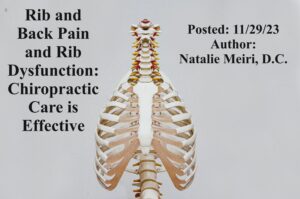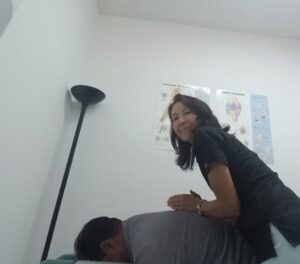
This is my clinical pearl story about Rib Pain and Rib Dysfunction: Chiropractic Care is Effective. She was a 24 year old female patient. To be HIPAA compliant, I will call her Jean instead of her real name.
Jean reported severe pain and graded the pain level to be 10/10. It was a dull, achy, sharp, stabbing pain radiating along the periphery of one or more ribs from the back to the front of her torso. She had difficulty breathing and couldn’t bend or twist at the waist due to pain. Jean also had difficulty even lifting her legs while sitting due to the pain in her left mid back.
Jean’s rib and back pain had come on suddenly while she was walking in the grocery store. There wasn’t any history of trauma. She did report having a similar incident of rib and back pain in the past. Recently, Jean was under a lot of stress from her college exams and projects. These projects had entailed a lot of leaning forward in a lab with bad posture. At first, she tried taking an over the counter NSAID (Non-steroidal anti-inflammatory drugs) and then called for an appointment with me.
Jean’s Examination
Upon examination I did find her range of motion was extremely limited in her thoracic and lumbar spine due to the mid back pain. Also, Jean’s cervical (neck) range of motion was decreased in several directions due to the pain in her mid back. Furthermore, she had an inability to raise her thighs from a sitting position during the muscle testing due to the pain in her mid back. She also tested positive for left rib chiropractic subluxations (fixated/misaligned joint) in her mid to lower thoracic (mid back) spine. Additionally, I explained to Jean that she had a lot of spasm in the surrounding musculature due to the chiropractic rib subluxations (serratus posterior and superior muscles, longissimus thoracis, iliocostalis lumborum, quadratus lumborum, and serratus posterior and inferior muscles).
I would order an x-ray of her left rib and mid back if she wasn’t making progress within 12 visits.
Jean’s Treatment and Outcome at Meiri Chiropractic in West Palm Beach
Jean received chiropractic adjustments/ manipulation to her cervical (neck), thoracic (ribs and spine in mid back) and lumbopelvic (low back) spine along with soft tissue work (myofascial release, pressure point and various post isometric relaxation procedures) and exercises to continue at home.
After her first adjustment, Jean started to feel better. In fact, she was able to rotate and bend her torso better. And by the second visit, she reported a pain level of 6/10 and had better range of motion overall. However, she still couldn’t lift her thighs from a sitting position. Finally, by her third visit she reported feeling “90%” better. Moreover, she was able to lift her thighs from a sitting position and had regained most of her range of motion back in her neck and back. So Jean at this point chose to return in a month for a followup.

Anatomy of the Thoracic (mid back) Spine and Ribs
12 Vertebrae (spinal bones) compose the thoracic vertebral column or spine. Your spine protects the spinal cord, nerves, supports your thorax and enables movement of your body. The intervertebral discs, along with the laminae, pedicles, and articular processes of adjacent vertebrae, create a space through which spinal nerves exit. A typical vertebra also contains four articular (joint) processes, two superior and two inferior, which contact the inferior and superior articular processes of adjacent vertebrae, respectively. The point at which superior and articular facets meet is known as a facet, or zygapophyseal, joint (synovial joint). These maintain vertebral alignment, control the range of motion, and are weight-bearing in certain positions. Also, these joints are what chiropractors mostly adjust in the thoracic spine.
Thoracic vertebrae are unique in that they have the additional role of providing attachments for the ribs. One special feature of thoracic vertebrae is the presence of costovertebral and costotransverse joints, which form the articulations for the ribs. The costovertebral joints (demifacets) are located on either side of the vertebral body to form an articulation with the heads of the ribs. The costotransverse joints are located on the anterior (front) aspects of the transverse processes of vertebrae to articulate with the tubercles of the ribs.
Anteriorly (front), the first seven ribs connect to the sternum (breast plate) directly, and the eighth, ninth, and tenth ribs attach indirectly via the costocartilage. The eleventh and twelfth ribs are free floating, with no anterior attachment. The anterior articulations move mainly because of the elastic quality of the costocartilage.
What is the Chiropractic Subluxation/ Joint Subluxation/Dysfunction Syndrome (JSDS)?
A Joint Subluxation/Dysfunction Syndrome (JSDS) diagnosis is defined by a combination of signs and symptoms for dysfunction of spinal, pelvic, or peripheral (limb) joints. It is a functional (biomechanical) diagnosis, not a structural (pathoanatomic) diagnosis. If you have JSDS, your spinal and peripheral motion segments and associated soft tissues are the source of your symptoms.
The chiropractic subluxation is the alteration of the normal dynamic, anatomic, or physiologic relationships of contiguous (neighboring) articular (joint) structures. It is a motion segment in which alignment, movement integrity, or physiologic function is altered. However, the contact between the joint surfaces remains intact. So the ORTHOPEDIC SUBLUXATION term which means a partial or incomplete dislocation, is different from the chiropractic subluxation.
And this aberrant relationship between two adjacent articular structures may have functional or pathologic sequelae (consequence of disease). The chiropractic subluxation can ultimately cause an alteration in the biomechanical or neurophysiologic changes to occur not only to your articular structures, but also your entire body systems.
Indeed, the rib synovial joints are prone to the same pathologic conditions that affect other synovial joints (also called diarthroses are freely movable joints), including the chiropractic subluxation and dysfunction complex.

Rib and Back Pain and Rib Dysfunction: Chiropractic Care is Effective
Chiropractors are specially trained to examine you for the presence of chiropractic rib subluxations, as well as involvement of any surrounding tissues. If detected, your chiropractor in West Palm Beach will use safe and effective chiropractic adjustments to restore proper rib movement. This will correct your “subluxations”, restore normal function to the affected area and get you out of pain.
Are you suffering from rib pain and searching for an experienced chiropractor in West Palm Beach? Dr. Natalie Meiri can definitely help you. Call 561-253-8984 today to find out more about Rib and Back Pain and Rib Dysfunction: Chiropractic Care is Effective or to make an appointment.